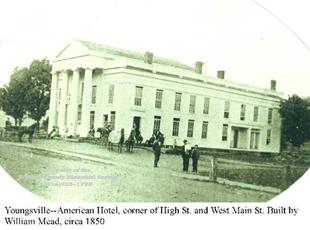.jpg)
Brokenstraw Township
.jpg)
Brokenstraw Township lies in the center of Warren County, and it was organized in I821. The Brokenstraw Creek cuts through its center and joins the Allegheny River which divides Brokenstraw Township from Pleasant Township on the east. Youngsville and Irvine are the two largest .jpg) communities in Brokenstraw Township.
communities in Brokenstraw Township.
The name Brokenstraw comes from an Indian name for the area. The Seneca named the area after a kind of grass growing on the Irvine Flats, which would fall over and break each year. In English, this was translated into Brokenstraw. Historically, the Seneca Indians had a large village on the area that is now Irvine Flats.
The only recorded “battle” of the Revolutionary War in Northwestern Pennsylvania took place in Brokenstraw Township. During the war, many Seneca Indians joined the British in fighting against the American colonists. In retaliation for Seneca Indian attacks on settlements to the east, the Revolutionary government sent Colonel Brodhead and a group of soldiers into Seneca territory in 1781. They left from Pittsburgh and traveled up the Allegheny River. Brodhead came upon a party of Seneca hunters on the Allegheny River, between what is now Tidioute and Irvine, and attacked. After a brief skirmish, Brodhead proceeded upriver and burned the Seneca village and their crops on the Irvine Flats. The Seneca never returned to this site.
.jpg) The first white settlers in the area were mostly lumbermen, attracted by the forests and the easy access to water transportation that allowed them to move their lumber to markets downriver. In order to turn the trees into useable lumber, a number of sawmills were built in the area. These early sawmills were built next to streams and rivers and used waterwheels to provide the power to run the mill machinery.
The first white settlers in the area were mostly lumbermen, attracted by the forests and the easy access to water transportation that allowed them to move their lumber to markets downriver. In order to turn the trees into useable lumber, a number of sawmills were built in the area. These early sawmills were built next to streams and rivers and used waterwheels to provide the power to run the mill machinery.
Youngsville swiftly became the largest settlement in Brokenstraw Township. It was named after a Scotsman, Matthew Young, who arrived in the area in 1796, and laid out many of its streets. Young’s Settlement, Youngstown, and Young’s Town are some of the names that the community went by until 1816 when it began being called Youngsville.
Young built a sawmill on the site. Stores, taverns, schools, and churches later followed as the community grew. For much of the nineteenth century, many of Youngsville’s businesses and industries depended on lumber. Saw, planing, and stave mills used lumber from the forests. Hotels and taverns, such as the American House and the Fairmont House fed and housed lumbermen on their way downriver.
An important institution, the Rouse Home, is situated near Youngsville. The Rouse Home (also called the Rouse Hospital) is partially funded by the estate of Henry Rouse, a businessman who died as a result of an early oil well fire in 1861. He left much of his money to the commissioners of .jpg) Warren County to be used for the county roads and the county poor. The commissioners purchased a 400 acre farm near Youngsville, and built a hospital/nursing home, which has since expanded.
Warren County to be used for the county roads and the county poor. The commissioners purchased a 400 acre farm near Youngsville, and built a hospital/nursing home, which has since expanded.
Irvine is another important community in Brokenstraw Township. Although much of the land in and around Irvine was originally owned by General William Irvine, the village of Irvine, also called Irvineton, grew up around the placement of the Philadelphia and Erie Railroad (P&E RR) line. In the early 1860s, before the railroads ran through the oil country downriver, flatboats full of crude oil in barrels made their way upriver to the station of the P&E RR at Irvine. In 1866, the Warren and Franklin Railroad was completed from Oil City to Irvine, making oil transportation by boat unnecessary. At the intersection of two railroads vital to the transportation of oil, Irvine became a bustling town. National Forge was, at one time, the largest employer in Irvine.

Courtesy of the Warren County Historical Society